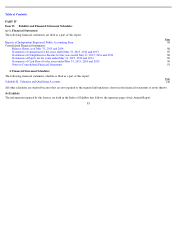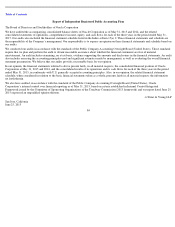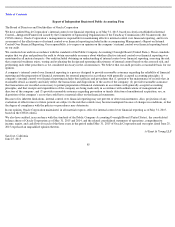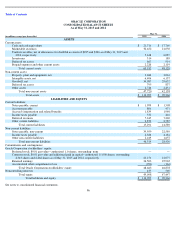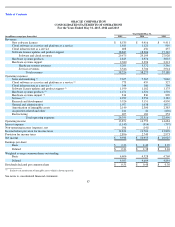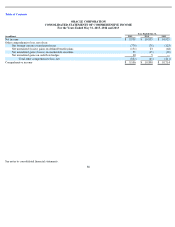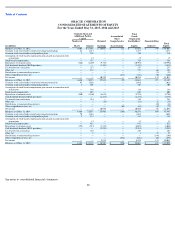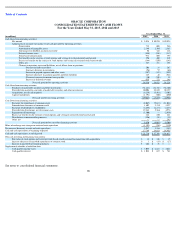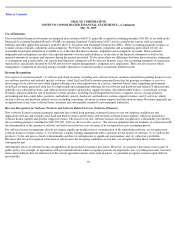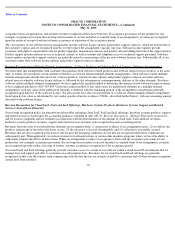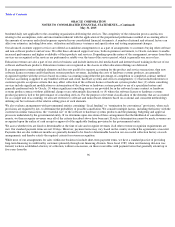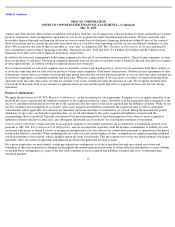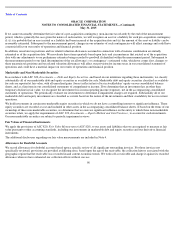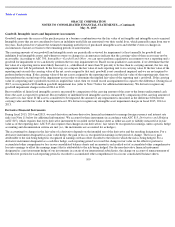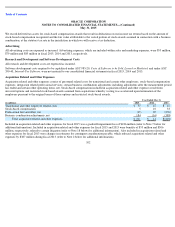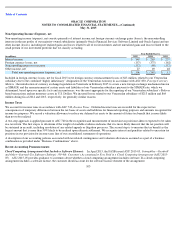Oracle 2014 Annual Report Download - page 97
Download and view the complete annual report
Please find page 97 of the 2014 Oracle annual report below. You can navigate through the pages in the report by either clicking on the pages listed below, or by using the keyword search tool below to find specific information within the annual report.
Table of Contents
ORACLE CORPORATION
NOTES TO CONSOLIDATED FINANCIAL STATEMENTS—(Continued)
May 31, 2015
acceptance terms are perfunctory and all other revenue recognition criteria have been met. If acceptance provisions are not perfunctory (for
example, acceptance provisions that are long-term in nature or are not included as standard terms of an arrangement), revenues are recognized
upon the earlier of receipt of written customer acceptance or expiration of the acceptance period.
The vast majority of our software license arrangements include software license updates and product support contracts, which are entered into at
the customer’s option and are recognized ratably over the term of the arrangement, typically one year. Software license updates provide
customers with rights to unspecified software product upgrades, maintenance releases and patches released during the term of the support period.
Product support includes internet access to technical content, as well as internet and telephone access to technical support personnel. Software
license updates and product support contracts are generally priced as a percentage of the net new software licenses fees. Substantially all of our
customers renew their software license updates and product support contracts annually.
Revenue Recognition for Multiple-Element Arrangements—Software Products and Software Related Services (Software Arrangements)
We often enter into arrangements with customers that purchase both software related products and software related services from us at the same
time, or within close proximity of one another (referred to as software related multiple-element arrangements). Such software related multiple-
element arrangements include the sale of our software products, software license updates and product support contracts and other software
related services whereby software license delivery is followed by the subsequent or contemporaneous delivery of the other elements. For those
software related multiple-element arrangements, we have applied the residual method to determine the amount of new software license revenues
to be recognized pursuant to ASC 985-605. Under the residual method, if fair value exists for undelivered elements in a multiple-element
arrangement, such fair value of the undelivered elements is deferred with the remaining portion of the arrangement consideration generally
recognized upon delivery of the software license. We allocate the fair value of each element of a software related multiple-element arrangement
based upon its fair value as determined by our vendor specific objective evidence (VSOE—
described further below), with any remaining amount
allocated to the software license.
Revenue Recognition for Cloud SaaS, PaaS and IaaS Offerings, Hardware Systems Products, Hardware Systems Support and Related
Services (Nonsoftware Elements)
Our revenue recognition policy for nonsoftware deliverables including cloud SaaS, PaaS and IaaS offerings, hardware systems products, support
and related services is based upon the accounting guidance contained in ASC 605-25, Revenue Recognition , Multiple-Element Arrangements,
and we exercise judgment and use estimates in connection with the determination of the amount of cloud SaaS, PaaS and IaaS revenues,
hardware systems products revenues, support and related services revenues to be recognized in each accounting period.
Revenues from the sales of our nonsoftware elements are recognized when: (1) persuasive evidence of an arrangement exists; (2) we deliver the
products and passage of the title to the buyer occurs; (3) the sale price is fixed or determinable; and (4) collection is reasonably assured.
Revenues that are not recognized at the time of sale because the foregoing conditions are not met are recognized when those conditions are
subsequently met. When applicable, we reduce revenues for estimated returns or certain other incentive programs where we have the ability to
sufficiently estimate the effects of these items. Where an arrangement is subject to acceptance criteria and the acceptance provisions are not
perfunctory (for example, acceptance provisions that are long-term in nature or are not included as standard terms of an arrangement), revenues
are recognized upon the earlier of receipt of written customer acceptance or expiration of the acceptance period.
Our cloud SaaS and PaaS offerings generally provide customers access to certain of our software within a cloud-based IT environment that we
manage, host and support and offer to customers on a subscription basis. Revenues for our cloud SaaS and PaaS offerings are generally
recognized ratably over the contract term commencing with the date the service is made available to customers and all other revenue recognition
criteria have been satisfied.
93


